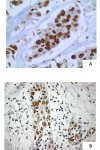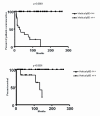Overexpression of Chromatin Assembly Factor-1/p60 helps to predict the prognosis of melanoma patients
- PMID: 20178651
- PMCID: PMC2843674
- DOI: 10.1186/1471-2407-10-63
Overexpression of Chromatin Assembly Factor-1/p60 helps to predict the prognosis of melanoma patients
Abstract
Background: Cutaneous melanoma (CM) is the most lethal form of skin malignancy, which registers a constant increase in incidence worldwide. The identification of molecular alteration(s) involved in its biological aggressiveness represents a major challenge for researchers, considering that existing therapies are ineffective to treat metastasizing cases. The epigenetic control of chromatin dynamics during DNA synthesis, replication, and repair is fundamental for the orderly progression of cell proliferation. The Chromatin Assembly Factor 1 (CAF-1) complex acts as a major regulator of this process; its intermediate (p60) subunit has been recently proposed as a novel proliferation and prognostic marker for several tumors. We aimed to establish if the evaluation of the expression of CAF-1/p60 in primary CM may help define the prevision of outcome of patients.
Methods: Immunohistochemistry with anti-CAF-1/p60 was performed on paraffin-embedded tissue sections of 130 cases of primary CM retrieved from the archive files of the Department of Biomorphological and Functional Sciences, Section of Pathology, University "Federico II" of Naples, Italy. Results were compared with histopathological and follow-up data of patients.
Results: CAF-1/p60 was expressed in all CM. A significant statistical association between the overexpression of the protein and the occurrence of skin, node and/or distant metastases (P < 0.05) emerged, independently from histopathological prognostic factors.
Conclusions: CAF-1/p60 looks promising as a new prognostic marker for CM and sheds new light on the molecular events associated with photocancerogenesis and melanoma biology.The screening for CAF-1/p60 might contribute to the molecular sub-classification of CM, with improved translational outcomes.
Figures





Similar articles
-
The role of the chromatin assembly complex (CAF-1) and its p60 subunit (CHAF1b) in homeostasis and disease.Biochim Biophys Acta. 2015 Aug;1849(8):979-86. doi: 10.1016/j.bbagrm.2015.05.009. Epub 2015 Jun 9. Biochim Biophys Acta. 2015. PMID: 26066981 Free PMC article. Review.
-
Tissue microarray-based evaluation of Chromatin Assembly Factor-1 (CAF-1)/p60 as tumour prognostic marker.Int J Mol Sci. 2012;13(9):11044-11062. doi: 10.3390/ijms130911044. Epub 2012 Sep 5. Int J Mol Sci. 2012. PMID: 23109837 Free PMC article.
-
The proliferation marker Chromatin Assembly Factor-1 is of clinical value in predicting the biological behaviour of salivary gland tumours.Oncol Rep. 2011 Jan;25(1):13-22. Oncol Rep. 2011. PMID: 21109952
-
Role of chromatin assembly factor-1/p60 and poly [ADP-ribose] polymerase 1 in mycosis fungoides.Virchows Arch. 2021 May;478(5):961-968. doi: 10.1007/s00428-020-02952-z. Epub 2020 Oct 24. Virchows Arch. 2021. PMID: 33098490 Free PMC article.
-
Epigenetic regulation in human melanoma: past and future.Epigenetics. 2015;10(2):103-21. doi: 10.1080/15592294.2014.1003746. Epigenetics. 2015. PMID: 25587943 Free PMC article. Review.
Cited by
-
Epigenetic disregulation in oral cancer.Int J Mol Sci. 2012;13(2):2331-2353. doi: 10.3390/ijms13022331. Epub 2012 Feb 21. Int J Mol Sci. 2012. PMID: 22408457 Free PMC article. Review.
-
Fractal dimension of chromatin is an independent prognostic factor for survival in melanoma.BMC Cancer. 2010 Jun 5;10:260. doi: 10.1186/1471-2407-10-260. BMC Cancer. 2010. PMID: 20525386 Free PMC article.
-
The role of the chromatin assembly complex (CAF-1) and its p60 subunit (CHAF1b) in homeostasis and disease.Biochim Biophys Acta. 2015 Aug;1849(8):979-86. doi: 10.1016/j.bbagrm.2015.05.009. Epub 2015 Jun 9. Biochim Biophys Acta. 2015. PMID: 26066981 Free PMC article. Review.
-
Overexpression of chromatin assembly factor-1/p60 predicts biological behaviour of laryngeal carcinomas.Acta Otorhinolaryngol Ital. 2017 Feb;37(1):17-24. doi: 10.14639/0392-100X-867. Acta Otorhinolaryngol Ital. 2017. PMID: 28374866 Free PMC article.
-
Asf1b, the necessary Asf1 isoform for proliferation, is predictive of outcome in breast cancer.EMBO J. 2011 Feb 2;30(3):480-93. doi: 10.1038/emboj.2010.335. Epub 2010 Dec 21. EMBO J. 2011. PMID: 21179005 Free PMC article.
References
-
- Markovic SN, Erickson LA, Rao RD, Weenig RH, Pockaj BA, Bardia A, Vachon CM, Schild SE, McWilliams RR, Hand JL, Laman SD, Kottschade LA, Maples WJ, Pittelkow MR, Pulido JS, Cameron JD, Creagan ET. Melanoma Study Group of the Mayo Clinic Cancer Center. Malignant melanoma in the 21st century, part 1: epidemiology, risk factors, screening, prevention, and diagnosis. Mayo Clin Proc. 2007;82:364–80. doi: 10.4065/82.3.364. - DOI - PubMed
MeSH terms
Substances
LinkOut - more resources
Full Text Sources
Medical

